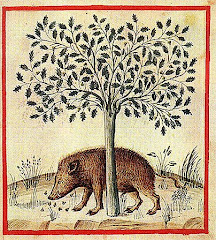Having started this blog, I have as yet to sort myself out camera-wise so that I can properly illustrate the things I'm talking about. I hope to remedy that soon, but in the meantime I decided to scour the public domain for some nice copyright-free imagery I could decorate the odd bit with.
What I found is what you see adorning every spare space on this blog (assuming they're still there at the time you read this) and they're so wonderful, and I've used so many of them, that even though the copyright has expired, I couldn't very well not acknowledge them.
There's something so fresh about these images which date back to some time around the 14th century. They don't have the dullness of a modern photo, nor the time-bleached dustiness of most historical herbal manuscripts. And is it just me, or do they contain a brilliant sense of humour and gaiety too?
They come from the Tacuinum Sanitatis, a medieval "handbook of wellness" based on an 11th century medical treatise by Ibn Butlan. It seems the high volume of illustrations was one if its main selling points, but I think the descriptions that go with them are also something to behold so I'm sorry not to be able to include more of them with the images.
Here are a few of my favourites, and I highly recommend visiting the rest on Wikimedia Commons (unless of course I've downloaded and displayed the whole lot by then so that you don't need to...)

Sugar (Saccharum sp.)
Nature: Warm in the first degree, humid in the second.
Optimum: The white, clear kind.
Usefulness: It purifies the body, is good for the chest, the kidneys, and the bladder.
Dangers: It causes thirst and moves bilious humors.
Neutralisation of the Dangers: With sour pomegranates.
Effects: Produces blood that is not bad. It is good for all temperaments, at all ages, in every season and region. [oh, if only!]

Woolen Clothing (Vestis lanea)
Nature: Warm and dry.
Optimum: The thin kind from Flanders.
Usefulness: It protects the body from cold and
holds warmth.
Dangers: It causes skin irritation.
Neutralisation of the Dangers: With thin linen clothing.
[now who could disagree with that? And isn't it useful to know the proper taxonomic name for underwear!]

The Fruit of the Mandrake (Mandragora officinarum)
Nature: Cold in the third degree, dry in the second.
Optimum: The highly fragrant variety.
Usefulness: Smelling it helps alleviate headaches and insomnia; spreading it on the skin works against elephantiasis and black infections.
Dangers: It stupefies the senses.
Neutralisation of the Dangers: With the fruits of ivy.
Effects: It is not comestible. It is good for warm temperaments, for the young, in Summer, and in the Southern regions.
[It looks as though the dog enjoyed its last supper at least]





















2 comments:
I love this it is so interesting how thing's were noted and conveyed to people, and what beliefs people had (and still do in some cases).
I'd love to see more of this stuff in, for example, BMA Family Doctor.
Keep the blog coming
Hi Katrina
Great blog! There is an anaesthetist working at North Staffs hospital, Dr Anthony Carter, who has written two great articles on the use of mandrake in anaesthesia. One is called Narcosis and Nightshade which appeared in the BMJ 1996;313:1630-1632 (21 December). Let me know if you'd like a copy.
Post a Comment